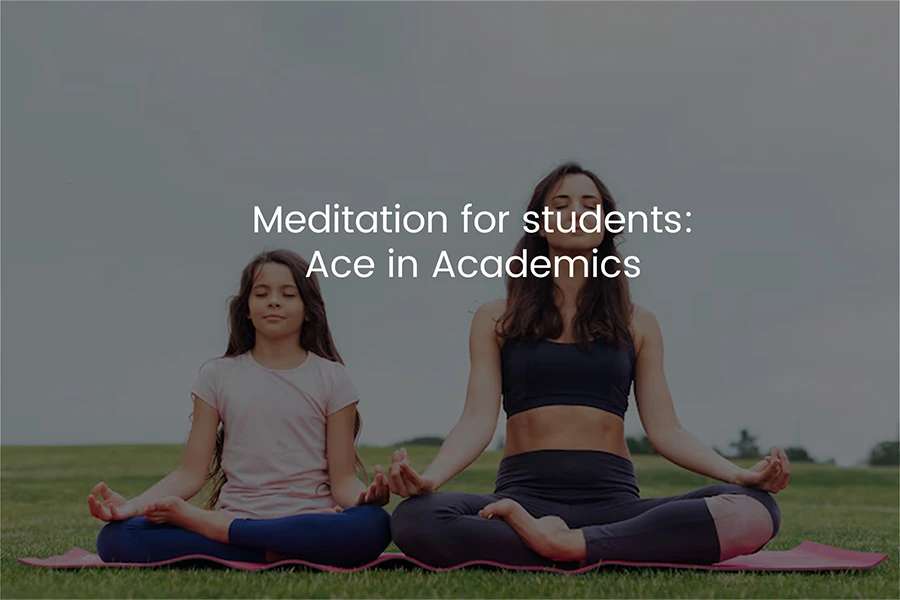The Health and Wellness Needs of Children
Schools play a pivotal role in supporting a child to make healthy lifestyle choices and understanding the impact of their choices. There is a direct link between overall wellness and academic performance and vice-versa. And being a student, they can harness the power of meditation and make learning fun and stress-free.
The Importance of Meditation for Students
Every child is different and so are their abilities to tackle academic and personal challenges. The constant challenge to stand up to parents, peers and societal expectations can cause mental drainage. As far as academics are concerned, success hinges on their ability to grasp massive amounts of information, which can lead to performing under pressure.
So whether it is solving complex equations, mastering new languages, preparing for exams or simply just trying to ‘fit in’, students are constantly under pressure. In this scenario, mediation appears as a saviour to fortify mental pressure and optimise learning. Researchs point out that bringing meditation into students’ routines can benefit their mental and physical health, improve concentration, focus, memory, sleep quality, develop self-awareness and problem-solving skills.
4 Types of Meditation for Students
- Mindfulness Meditation: This is a type of meditation practice, where one focuses on the ideas as they move through the mind. Mindfulness meditation is about being present and not getting distracted by thoughts of the past or tension of the future. It involves focusing on what one is feeling with 100% attention and focus.
- Focused Meditation: This meditation practice involves using all five senses and focusing entirely on them to stay in the present. Focused meditation is all about zeroing in on the details of something so much that one cannot see anything else. This type of meditation helps students deepen focus, concentration and attentiveness.
- Breathing Meditation: Breathing exercises can help make the mind sharper. This form of meditation involves using breathing as a subject of focus. It allows students to focus on present positive moments, helping them feel peace and calm throughout the day.
- Mantra Meditation: Mantras Ohm and Aham Prem are Yogic devices that are based on sacred sounds to evoke psychological states. The mental and verbal recitation improves focused awareness and eliminates negativity.
Helpful Read: Sound Healing for students & educators to improve performance
6 Benefits of Meditation for Children
- Reduces Stress Level: Academics can be stressful and challenging for students. Incorporating meditation into children’s daily routines can help reduce stress and anxiety. During mediation the mind is in a deep state of relaxation and peace, attaining mental clarity.
- Enhances Self-Awareness: Meditation allows one to gain self-introspect and observe self-awareness. With regular meditation practice, students foster self-awareness and knowledge that can help them understand themselves better and lead to personal & academic growth.
- Academic Performance: One of the major benefits of meditation for children is that allows more focus and attentiveness to their studies and future prospects. Mediation is an effective way to help students combat distractions and improve concentration levels.
- Improves Mental Health: Regular meditation is known to improve health by reducing stress levels and anxiety. This helps to achieve an improved ability to focus optimally on tasks, enhance brain efficacy and grasp new concepts.
- Promoting Good Sleep: Quality sleep is key to optimal health and wellness. With regular meditation, it promotes a healthy sleeping pattern to relax and rejuvenate the body and mind.
- Promotes Overall Wellness: The benefits of meditation are beyond academics, influencing other aspects of life. It promotes overall wellness and mental clarity by enhancing student capacity to manage extracurricular activities, maintaining healthy relationships and cultivating a balanced lifestyle.
4 Tips to Incorporate Meditation into Children’s Routine
Incorporating meditation into children’s routines helps relax the mind and energises the body. Here is how you can incorporate meditation into your child’s routine.
- Create an Environment of Calmness: Implement a daily meditation place that is warm, and brightly lit, with Yoga mats, essential oils and calm. Happy teachers and a warm environment can help kids manage their emotions better through meditation. Create a calm meditation room at home where the child feels free to be themselves.
- Lead By Example: Children mirror elders’ behaviours. Parents can start their own Yoga practice and then teach their children. The more they see parents meditating the more interested they will be in the activity.
- Create Mindfulness Routines Before Bed: Sleep and health go hand-in-hand. As a family make rules around mobile phones and other electronic devices. This is especially relevant for teenagers who are more prone to get attached to social media. Incorporate mindfulness practice into teens’ lives to just appreciate and live in the present moment.
- Practise Consistently: Consistency is the key. Keep the mediation session short to align with children’s attention span.
Solution to Student’s Academic Issues: EmpowerED
FindYourFit’s school health and wellness program (EmpowerED) emphasizes the wellness needs of students. Through EmpowerED, we equip teachers, principals, parents, and students with the tools and support they need to thrive in all aspects of their lives.
EmpowerED encomposes mental, physical and emotional dimensions in nurturing children. We strongly emphasize addressing mental health challenges in schools by providing comprehensive counselling, nurturing emotional wellness, and culture of healthy eating. Stress management and mindful techniques like meditation equip students with valuable coping strategies to tackle academic and personal life challenges and new demands.
Recent Event of School Wellness Program
EmpowerED reaffirms its commitment to holistic well-being and nurturing future generations. FindYourFit’s EmpowerED was successfully launched offline with teachers and principals from 75+ schools on 2nd May 2024, in Jaipur Rajasthan. We helped students to improve concentration, boost memory, self-awareness, happiness, relaxation and enhance overall wellness.
To launch EmpowerEd in your school, get in touch with us today.




